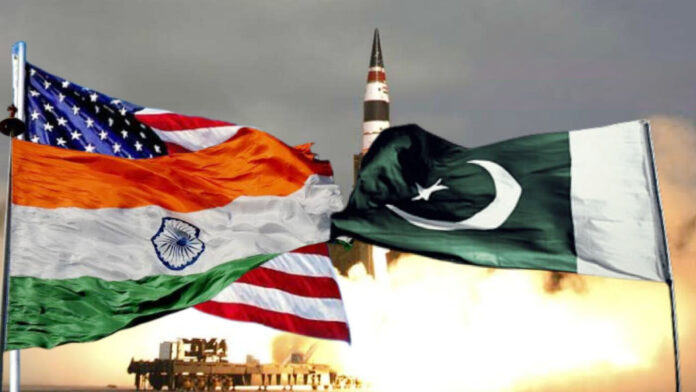“We must approach our relationship with India with greater wisdom and prudence,” Colin Powell, US Secretary of State.
The strengthening of India-US ties has not only been a significant concern to Pakistan but has also garnered global attention. India’s strategic alliance with the USA is shifting security dynamics in South Asia to its advantage, increasing insecurity in the volatile region. The USA’s desire to maintain the unipolar world order and its dominance on the world stage is reflected in the strategic alliance between it and India. Similarly, with the assistance of the USA, India also wishes to establish itself as a dominant power in the South Asian region. Both states are pursuing their interests through cooperation, which has been strengthening over time, and this cooperation remains an area of concern for maintaining stability in South Asia.
Therefore, Pakistan is forced to take action to reestablish the strategic equilibrium in the region due to India’s significant arms acquisition push. As the Indian-American alliance threatens Pakistan’s security, Pakistan could opt for a military alliance with China or Russia to counter the security threat. This, however, could further destabilize the region if these nuclear states engage in a new arms race
The post-Cold War era saw a significant shift in Indo-US relations as they gradually entered a strategic alliance. In order to address their common global concerns, both countries realized the significance of strengthening their relations. India profited enormously from US efforts to deepen political and economic ties with India. India and the USA also developed a multifaceted strategic alliance that encompassed defence, security, technology, people-to-people interactions, and economic and diplomatic cooperation. Furthermore, the threat of the rise of China had the USA cooperate with India to maintain US leadership in the region. India, having a large population, military power, and advancing economy, is considered an important ally of the USA in order to serve as a crucial factor in maintaining geopolitical equilibrium in the face of a growing China. China is expected to pursue its goal of strategic supremacy, which calls for more cooperation between the USA and India. As a result, this will further support and strengthen their defence ties.
Farwa Aamer and Kalyankar, in an article published in the Diplomat, have highlighted that 2023 marked a significant milestone in the relationship between the USA and India. Summits involving two heads of state, groundbreaking agreements on defence co-production, a new technology partnership, and cooperation on global issues point out the recent growth in mutual understanding and a commitment to the relationship’s long-term course. This growing partnership was consolidated by Indian Prime Minister Narendra Modi’s June 2023 visit to the USA Significant actions, including US President Joe Biden’s state dinner and Prime Minister Modi’s joint congressional speech, highlighted Washington’s growing appreciation of India as a critical strategic and economic ally. The September 2023 G20 summit also provided an opportunity for Modi and Biden to evaluate bilateral initiatives and demonstrate multilateral solidarity.
The USA’s tilt towards India is a major concern for Pakistan’s security. It challenges the current balance of power between India and Pakistan and paves the way for an arms race. It is assumed that the USA’s enhanced military support for India favours one side over the other and heightens tensions that already exist. Moreover, India was also designated as the region’s “net security provider” by the USA. However, this claim was refuted by the Pakistani National Security Committee in 2017, declaring that as India has conflictual relationships with its neighbours and seeks a policy of undermining Pakistan’s stability, it cannot become a net security provider in the region. The Indo-US nuclear deal also raised concerns for Pakistan since it intends to intensify India’s efforts to corner the country.
India has long been determined to assert its dominance in South Asia, and its primary goal in foreign policy is to become the dominant power in the region. India seeks to establish itself as a regional hegemon with the legitimacy and acceptance of other states. It has sought to influence neighbouring nations such as Nepal, Bangladesh, and Sri Lanka. However, the rise of China, with its infrastructure and economic projects, poses a challenge to India’s dominance in South Asia. India’s desire to dominate the region is threatened, and it now needs more room to benefit from small regional economies. Therefore, with the backing of the USA, it aims to establish its dominance, threatening the balance of power in South Asia.
The significant increase in Indian armaments and the disparity between India’s and Pakistan’s conventional capabilities negatively impact South Asia’s strategic equilibrium. India prefers to continue its goal of controlling the area by employing harsh measures to incite unrest in its surrounding states. India’s military and economic strength are considered by its neighbours as instruments for pursuing its geopolitical, economic, and military objectives in the area. India also regards the US alliance as a chance to advance its geopolitical objectives inside and outside the region. Due to India’s growing strategic alignment with the USA, Pakistan aims to maintain a strategic equilibrium while avoiding an arms race and maintaining regional peace.
Therefore, Pakistan is forced to take action to reestablish the strategic equilibrium in the region due to India’s significant arms acquisition push. As the Indian-American alliance threatens Pakistan’s security, Pakistan could opt for a military alliance with China or Russia to counter the security threat. This, however, could further destabilize the region if these nuclear states engage in a new arms race.























